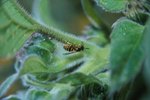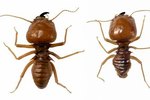
Many solitary wasps -- those who live alone instead of in colonies -- create small underground nests, but several types of social wasps build elaborate structures beneath the ground's surface. You might not know the nest exists until you step too close and end up on the wrong end of a wasp's sting. Several animals eat these ground-dwelling wasps, breaking open their nests to reach the honey and larvae inside.
What's for Dinner
Adult wasps tend to eat flower nectar, primarily. Many species carry pollen back to the hive to share with the colony's larvae in the form of honey. Ground wasps might not be as prolific in the honey-making department as some types of bees, but they provide enough to nourish the larvae until they're old enough to seek out their own flower nectar. All three pieces of the puzzle -- the adult wasps, the larvae and the honey -- attract different types of animals to the nest.
Tasty Wasp Treat
Many animals brave the stings that come with hunting and eating the ground-dwelling wasps. A bear's fur helps protect him; an armadillo's shell does the same. Both animals have strong forearms and claws that help them dig into wasp nests. Rats, weasels and skunks enjoy meals of wasps periodically, as do bats and a variety of birds. These animals aren't desirable in most landscapes, but they help control the wasp population without the use of insecticides.
Going for What's Inside
Not all animals who attack ground wasp nests are after the adult wasps. Instead, many disrupt the nests, killing or confusing the adults, as they seek out the honey and the larvae. Larvae are protein-packed snacks, and honey is a powerful source of energy. Bears enjoy both, while creatures such as raccoons and skunks dig mostly for the honey.
Predators of the Six-Legged Variety
Solitary wasps often make meals of other wasp species, including the ground-dwelling types. But wasps must watch out for more than their own kind: Robber flies aren't afraid to grab a wasp for a meal, and neither are some species of moths and beetles. Some parasitic wasps, such as the cow killer wasp, lay eggs inside other wasps; the larvae then use the host wasp as a meal as they mature.
References
- Pest World for Kids: Wasps
- Minnesota Department of Natural Resources: Black Bear Yearbook -- January-February 1993
- SierraWild.gov: Eating and Sleeping
- Beyond Pesticides: Wasp and Yellowjacket Control
- Eat the Weeds: Armadillo -- Possum on the Half Shell
- Texas A&M AgriLife Extension: Ground-Nesting Wasps and Bees
Photo Credits
-
Jupiterimages/liquidlibrary/Getty Images




